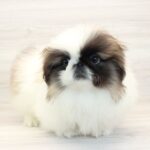If you’re considering getting a mini Labradoodle, it’s important to learn about their typical traits before you bring one home. These include their size, coat, temperament, and health concerns. In addition, this article will address how to properly socialize your new pet. In addition, you’ll discover how to train your mini Labradoodle to respond to new people.
Size
The size of a Mini Labradoodle depends on several factors. First, you have to take into account the parent size. If both parents are small, you can expect the puppy to be smaller, too. However, this cannot be predicted 100%. It may be smaller than its parents or bigger than their siblings.
A Labradoodle weighs between seven and thirteen kilograms (13 and 25 pounds). They need about as much exercise as a standard Labrador or Poodle. If they are left alone for long periods, they will use this pent-up energy to get into mischief. This is why Labradoodles do best in a household where there is a lot of human interaction.
While the Mini Labradoodle is a smaller breed than the standard Labrador, they are highly trainable and have excellent social skills. They are great for homes with small children as well as small spaces. However, they do need a lot of attention, and they will need a lot of grooming.
The size of a Mini Labradoodle can vary widely, so be sure to pay attention to the size of your potential pup before you choose a dog. However, the Poodle parent is more likely to produce a Mini Labradoodle that is small compared to its parent. This may result in a smaller dog, but it can still make for a handsome family pet.
Size of a Mini Labradoodle: The mini Labradoodle is the result of the cross between a Labrador and a Poodle. As a result, they are smaller than the standard Labrador and are generally between twenty and thirty pounds.
Temperament
A Mini Labradoodle has the same temperament as its larger Labradoodle counterpart. They share the same loving, friendly, and intelligent characteristics. The main difference between the two is size. The Mini Labradoodle is much smaller and occupies less space. This characteristic makes the Mini Labradoodle a good choice for apartment-living situations.
A Mini Labradoodle can inherit traits from either of its parents. These traits include being high-spirited, tolerant, and playful. It is a smart, athletic, and adaptable dog. However, a Mini Labradoodle may be high-strung or sensitive.
Mini Labradoodles are available in a wide variety of coat colors. Depending on the coat color you choose, you can choose from grey, cream, and red. Other colors include chocolate, caramel, apricot, black, and tan. The coat color of a Mini Labradoodle varies based on its breed.
The Mini Labradoodle is a great family dog and a great choice for active families. They shed minimally and do not require constant grooming. They can be found in a wide variety of colors and fur types, and are fiercely intelligent and loyal. If you are looking for a low-shedding pet that is both affectionate and smart, a Mini Labradoodle may be the right fit for your home.
Coat
Mini Labradoodles have a soft, silky coat that is often referred to as a wool coat. This type of coat is so soft that people often can’t keep their hands off it. The coat is also commonly referred to as the “curly” type. You can easily tell which one is wool by the texture and tight curl pattern.
The coat of a Labradoodle undergoes a number of changes during its life. The coat sheds during the first year of life, but grows back over time. The color and texture of the coat also change as a Labradoodle ages. The climate they live in may affect the coat color.
The coat of a Labradoodle can be a mixture of different colors, but in most cases, it’s the same color as its parents. Black Labradoodle puppies, for example, often develop a brown hue over their coats, and white Labradoodle pups have light underlayer fluff. The coat is likely to tangle and shed, so you should carefully check the coat of your prospective puppy.
A Labradoodle with a curly coat is generally low-shedding, but first-generation puppies may have more hair than the second or third generations. This may be an important consideration for people with allergies to hair. Fortunately, there are genetic tests to determine whether a dog’s coat is curly, straight, or flat.
The coat of a Labradoodle is an eye-catching feature of this breed. These dogs have three main coat types: wool, fleece, and hair. Each has its own advantages and disadvantages. Breeders try to create labradoodle puppies with the most beautiful, luxurious, and allergy-friendly coats possible.
Medical concerns
If you have a mini Labradoodle, you may be concerned about some of the health concerns they face. These conditions can be debilitating and can lead to a lot of pain and lameness. It is important to seek treatment early if you suspect a problem. You may be able to help your dog get better without the need for surgery.
There are several different medical concerns that you should be aware of, depending on your pet’s lifestyle and genetics. Because Labradoodles are hybrids, they can develop joint problems. These issues can cause your dog to become irritable and unenthusiastic. Your vet can help you determine the best treatment options for your mini Labradoodle.
One of the most common health concerns in mini Labradoodles is patellar luxation. This condition causes the kneecap to splay or slip out of its socket. If your dog has this condition, he will most likely limp or kick his leg behind him, or even skip running on the leg affected. In order to correct the issue, your veterinarian will likely recommend surgery to deepen the groove in the femur to make it more difficult for the kneecap to slip out.
Similarly, some dogs can develop allergies to certain foods. Food allergies can vary in severity, so it is important to pay close attention to your dog’s typical eating habits and watch for any symptoms of an allergic reaction. It’s vital to feed your mini Labradoodle a healthy diet. However, these health concerns can be tricky to manage.
Another health issue that could affect your pet is a heart problem. Your vet will perform a full cardiac exam, ultrasound, and chest x-rays to help diagnose any problems. If TVD is causing your dog to have a heart problem, your vet may recommend a low-fat diet.
Lifespan
There are several different health issues that can affect the life span of a mini labradoodle. Some of them are preventable, such as keeping your puppies healthy and happy. While some illnesses are hereditary, others can be managed. Regular vet visits can help ensure your pet has the healthiest life possible.
Mini labradoodles can develop diseases such as hip dysplasia, a hereditary condition. The disease affects the hip joint and begins during puppyhood. This can make it difficult for your Labradoodle to do things like climb stairs or get out of a dog bed. Fortunately, this type of disease is not as common in small breeds as it is in larger dogs.
Proper grooming and health care are also important in extending the life span of a mini labradoodle. These puppies are prone to ear infections, so it is important to brush their ears regularly and check for signs of allergies. A proper diet contains important minerals and nutrients and helps your dog stay healthy and active. Getting your dog plenty of exercise is another important aspect of Labradoodle care.
The lifespan of a mini labradoodle is longer than that of a standard Poodle. Standard Poodles live for about 12 years on average, while Mini labradoodles live for approximately fourteen years. The lifespan of a mini labradooodle depends on many factors, including diet, exercise, and vet care.
Colors: Mini Labradoodles come in a variety of colors, including white, caramel, chocolate, and apricot. They can also be white, tan, caramel, and silver.






